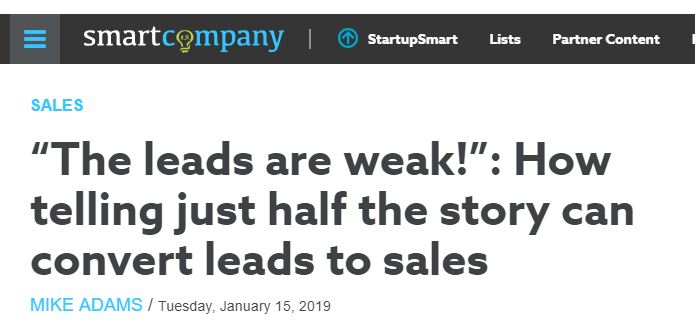What's your DISCOVERY MEETING MINDSET?
What are you trying to achieve in that all-important first meeting?
Here is a STORY METAPHOR that may help ...
[VIDEO TRANSCRIPT]
The Discovery Meeting. The first meeting with a potential client. I think it's the most important meeting in business. If it goes well, you might have a new client for decades. And if it goes badly. You've probably got nothing.
Most of those books over my shoulder teach questioning frameworks. Ask this question… then this question, then this question. When I teach salespeople how to conduct a discovery meeting, there's a couple of pretty serious problems with that approach.
One is understanding the correct intent. And it's not apparent in those (questioning) models. And the second is most salespeople struggle to follow those models.
I'd like to introduce the concept of a STORY MEETING - a different way to think about the discovery meeting, that first critical meeting. And I want to introduce a metaphor. I'd like you to imagine yourself (the salesperson) as a MOVIE DIRECTOR.
You are the movie director and you're looking to see if you can make your client THE STAR of your new movie. But why should a famous actor even meet with you the movie director? Well, if you think about it, there's only two reasons. The first would be, you've had a lot of successful hits in star's genre.
So you have some SUCCESS STORIES. OR, you've got a great idea - a great PLOT idea that they could star in. And that's the equivalent of an INSIGHT STORY.
So you get the meeting with your INSIGHT STORY or your SUCCESS STORY. And now you're going to consider your job in the meeting is to get that movie plot. To flesh-out that movie that you're going to make with your client.
You probably remember that there's four parts to a business story. We've got a setting, complication, a turning point and a resolution. But the movie you're going to make has four different names to the parts. The setting is called the BACK STORY. You need the backstory and then we need to SAVE THE HERO from dying. Because in a movie the hero nearly dies three or four times. So that's the complication. Then the hero SUCCEEDS the hero wins the battle and finally we have the LEGACY, what's… what's the follow on sequence.
When the star of the movie is sitting on the porch at the end in that last scene. With his bride or with one of his children. Looking back at that victory and thinking, yeah, that's what it meant. That's the legacy. That's the legacy of the hero’e success.
So we need to get those four parts. We just need to have four conversations within the discovery meeting. We'll start with the backstory and the way we do that is by telling our personal story mixed with that company story. That's the normal story we would tell first and we tell that story to ask the question - "What about you? How did you become a movie star? get into your role? How did your company get to where it got to?"
We exchange stories to get the backstory.
Then I normally coach you to skip the complications and talk about the success. How is success going to look? Then we can come back and look at the ways the hero could nearly dieAnd introduce our LIGHT SABRE, our special tools, those MAGIC KEYS that will prevent the hero from dying in this story.
And then we need to talk about the legacy. In the big picture where does it fit in with their whole company? What's it gonna mean a couple of years or five years down the track? And what would that mean for their career?What would be the legacy of this project that we're going to do?
... this movie that we're going to shoot?
So those are the four parts. If you can remember the four parts of the story. You can remember the four parts of the conversations that you to have. Of course, there are going to be questions. But really we're thinking about this as a natural conversation in four parts. We don't have to get the four parts in the right sequence. We can put the story back together afterwards.
And the beauty of this is that the proposal that we write is simply that story - It's the movie plot. That's the proposal. The best proposals read like a movie. Furthermore, we tell that story back to our boss When the boss asks how did the how did the meeting go? Most bosses, I can tell you, I was a sales manager for 20 years and most of my clients share this frustration - The salesperson comes back from the meeting and cannot answer the basic questions about the client situation.
But you can!!… You can lay out the entire plot - the backstory, how they going to win with your products and services and what it's really going to name for their company. That story is going to help you get the critical resources that you need internally to be able to deliver that project. Furthermore, your client, on receiving your story, your plot, will be able to share that story within their organization and persuade the other stakeholders. Maybe people that you don't even meet. So that people are being persuaded to make this movie. They like that plot because you put it in a story format that they can understand.
So when you think about the discovery meeting, think about being a movie director,and making your client the STAR!
The movie director and the star of the movie are on the same social level. You're not "helping" or trying have a "relationship" which is what a lot of people think that sales is about, that puts you at a low social status and you're not a detective using questions like an inquisitor to find out logically why they must buy from you, or someone challenging them and pretending you know more about their business tahn they do. That's above them on a social level.
No, you're meeting as equals, you are the director and they are the - star and you're gonna do this together.
And that's the right - it's the right social status to have in the discovery meeting, and it's much easier to remember the Hollywood movie and the four parts of the movie, that you need to have a conversation about to conduct a great discovery meeting!
Tell me what you think in the comments. I'd love to hear what you think, I'm Mike Adams.



